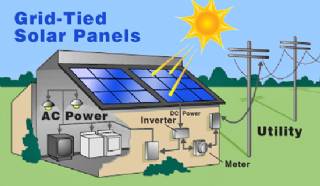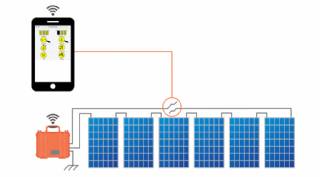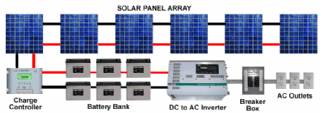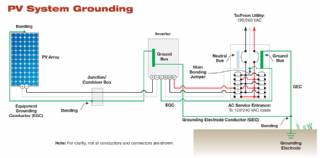Energy Conversion - Energy Transformation - Conversion Of Energy - Energy Converter
It is important to understand that losses are encountered during the transformation of energy during the different conversions into the final form for a given application, for example consider a wind turbine, the following conversions take place:
Kinetic energy of the oncoming air strikes the rotor blades, turning them, and hence the axial kinetic energy is turned into mechanical energy of the rotating blades.
Some of this mechanical energy is lost in the control mechanism, consisting of the gear box and brake to regulate the speed and match it with that of the generator. Some energy losses are encountered due to friction.
The shaft turning with the remaining energy will rotate in turn the generator; hence converting it’s the output into electrical energy (mechanical to electrical).
Some losses are dissipated through the mechanical connections between the turbine and the electrical generator.
Electricity is used by customers for lighting / heating or to operate electric devices such as radio, television, etc. electrical devices are designed to operate on an optimum condition; efficiency of the operation will vary depending on its use, age and maintenance.
The energy flow for a typical wind turbine is shown in Figure 1.1; can be analysed in a simple way by considering the energy flow diagram, which may look like this:
100 units of energy are stored in the incoming air as kinetic energy.
40 units are converted into rotational /mechanical energy by the blades.
35 units are transferred by the shaft; some units are absorbed by the brake and gear.
33 units are converted from mechanical into electrical energy in the electrical generator.
30 units is the net output, as 3 units are lost in voltage conversion, storage and distribution.
The final figure depends on many factors, including the type of turbine, efficiency of the control system, efficiency of the generator, and the quality of the transformer and the distribution system.
Labels
Energy ConversionEnergy Transformationconversion of energyEnergy Converterenergy transformation examplessolar powerenergy conversion examplessolar conversionsolar energy conversionenergy management softwarealternative energyrenewable energy sourceswind energyFarming Principle: Deep Soil Preparation
Looking at GB as a three-legged stool, deep soil preparation is one of the legs. Deep soil preparation builds soil and soil structure by loosening the soil to a depth of 24 inches (60 cm). Ideal soil structure has both pore space for air and water to move freely and soil particles that hold together nicely.

Smart Home Ecosystem - Smart Home Automation - Smart Home Security - Smart Home Technology
The outer-most level corresponds to the individual devices and sensors that consumers interact with. Several candidates are vying for the role of a leader introducing smart home services to the mass market.

Solar Energy Systems - Solar Modules - Solar Electric System Design - Solar Power
The heart of a photovoltaic system is the solar module. Many photovoltaic cells are wired together by the manufacturer to produce a solar module. When installed at a site, solar modules are wired together in series to form strings. Strings of modules are connected in parallel to form an array.
Solar Energy Systems - Array Mounting Racks - Solar Ray - Solar Panel - PV Racks and Mounts
Arrays are most commonly mounted on roofs or on steel poles set in concrete. In certain applications, they may be mounted at ground level or on building walls. Solar modules can also be mounted to serve as part or all of a shade structure such as a patio cover. On roof-mounted systems, the PV array is typically mounted on fixed racks, parallel to t

Solar Energy Systems - Grounding Equipment
Grounding equipment provides a well-defined, low-resistance path from your system to the ground to protect your system from current surges from lightning strikes or equipment malfunctions. Grounding also stabilizes voltages and provides a common reference point. The grounding harness is usually located on the roof.

Solar Energy Systems - Solar Inverter - Solar Panel Inverter
Most grid-connected inverters can be installed outdoors, while most off-grid inverters are not weatherproof. There are essentially two types of grid-interactive inverters: those designed for use with batteries and those designed for a system without batteries.

Solar Energy Systems - Solar Disconnects
Automatic and manual safety disconnects protect the wiring and components from power surges and other equipment malfunctions. They also ensure the system can be safely shut down and system components can be removed for maintenance and repair.

Solar Energy Systems - Solar Battery Bank
Batteries store direct current electrical energy for later use. This energy storage comes at a cost, however, since batteries reduce the efficiency and output of the PV system, typically by about 10 percent for lead-acid batteries. Batteries also increase the complexity and cost of the system.

Solar Energy Systems - Solar Charge Controller
A charge controller, sometimes referred to as a photovoltaic controller or battery charger, is only necessary in systems with battery back-up. The primary function of a charge controller is to prevent overcharging of the batteries. Most also include a lowvoltage disconnect that prevents over-discharging batteries. In addition, charge controllers pr

Solar Energy Systems - The NEC and PV Systems
Solar PV systems must be installed in accordance with Article 690 of the National Electric Code, which specifically deals with PV systems, as well as several other articles of the NEC that pertain to electrical systems in general. When there is a conflict between NEC 690 and any other article, NEC 690 takes precedence due to the unique nature of PV